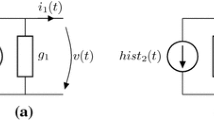Abstact
Electromagnetic transient simulation for large-scale power system is a time-consuming problem. A new frequency-dependent equivalence method is presented in the paper, which might significantly accelerate power system electromagnetic transient simulation. In the method, an effective algorithm is designed to directly transfer the port admittance determinant of external system’s mixing matrix into admittance rational function; and the step-by-step strategy for the equivalence of actual large system is put forward, which further reduces the calculation quantities needed. Moreover, the study of multiple real root pole characteristics of admittance transfer function of two-port network is performed and a proposition is achieved. Based on the proposition and residue theorem, the equivalence system for external system corresponding to the admittance rational function is obtained. The computation complexity of the step-by-step equivalence method is about o(⌋n/n p ⌉×t)(⌋⌉ is upper integral operation, n is the total buses number of external system, N P is the total buses number of single step equivalence network, T is single step equivalence time), which indicates that the computation complexity of the method proposed has nearly linear relationship with the buses number of external system, and the method proposed has satisfactory computation speed. Since the mixing matrix of external system includes all the information of external system, therefore, port admittance rational function derived from it can reflect its full frequency characteristic and the equivalence network achieved has high equivalence precision. Moreover, since the port rational function is gained at the condition of the external system without source, which equals stable passive network, it could not show any unstable pole and need not extra measure to make the equivalence system stable. The test results of the samples and comparison with other methods demonstrate that the new method proposed is valid and effective.
Similar content being viewed by others
References
Chen S M, Huang L L, Xie H B, et al. Transient interaction of HVAC and HVDC in converter station in HVDC: Equivalence circuit in AC side and steady-state debugging (in Chinese). High Voltage Eng, 2007, 37(3): 537–547
Sun H B, Zhang B M, Xiang N D. Nonlinear error analysis and application of ward-type equivalent.Autom Elect Power Syst, 2008, 32(13): 11–15
Watson N R, Arrillaga J. Frequency-dependent A. C. system equivalents for harmonic studies and transient convertor simulation. IEEE T Power Deliver, 1988, 3(3): 1196–1203
Hingorani N G, Burbery M F. Simulation of AC system Impedance in HVDC system studies. IEEE T Power Apparatus Syst, 1970, PAS-89(5): 820–828
Morched A S, Ottevangers J H, Martf L. Multi-port frequency dependent network equivalents for the EMTP. IEEE T Power Deliver, 1993, 8(3): 1328–1335
Ibrahima A I, Salama M M A. Frequency dependent network equivalents for electromagnetic transient studies. Elect Power Energy Syst, 1999, 21(6): 395–404
Ubolli A, Gustavsen B. Comparison of methods for rational approximation of simulated time-domain responses: ARMA, ZD-VF, and TD-VF. IEEE T Power Deliver, 2011, 26(1): 279–288
Watson N R, Arrillaga J. Power Systems Electromagnetic Transients Simulation. 1st ed. London: The Institution of Electrical Engineers, 2003. 251–266
Waston N. R. Improved fitting of z-domain frequency dependent network equivalents for electromagnetic transient simulation. The 8th International Power Engineering Conference (IPEC 2007), Dec. 3–6, 2007, Singapor, 2007. 401–406
Wang Y. P, Watson N R. Z-domain frequency-dependent AC-system equivalent for electromagnetic transient simulation. IEE Proc-Gener Transm Distrib, 2003, 150(2): 141–146
Waston N R, Gole A M, Irwin G D, et al. Z-domain frequency-ependent network equivalents for electromagnetic transient studies. IPST 99-International Conference on Power Systems Transients, June 20–24, 1999, Budapest, 1999. 37–42
Gustavsen B, Semlyen A. Simulation of transmission line transients using vector fitting and modal decomposition. IEEE T Power Deliver, 1998, 13(2): 605–614
Gustavsen B, Semlyen A. Rational approximation of frequency domain responses by vector fitting. IEEE T Power Deliver, 1999, 14(3): 1052–1061
Gustavsen B. Computer Code for Rational Approximation of Frequency Dependent Admittance Matrices. IEEE T Power Deliver, 2002, 17(4): 1093–1098
Ramirez A. Vector fitting-based calculation of frequency-dependent network equivalents by frequency partitioning and model-order reduction. IEEE T Power Deliver, 2009, 24(1): 410–415
Gustavsen B, Semlyen A. Enforcing passivity for Admittance Matrices Approximated by Rational Functions. IEEE T Power Syst, 2001, 16(1): 97–104
Coelho C P, Phillips J, Silveira L M. A convex programming approach for generating guaranteed passive approximations to tabulated frequency-data. IEEE T Computer-Aided Design Integr. Circuits Syst, 2004, 23(2): 293–301
Saraswat D, Achar R, Nakhla M S. Enforcing passivity for rational function based macromodels of tabulated data. In: Electrical Performance of Electronic Packaging. Princeton, 2003. 295–298
Lamecki A, Mrozowski M. Equivalent SPICE circuits with guaranteed passivity from nonpassive models. IEEE T Microw Theory Tech, 2007, 55(3): 526–32
Gustavsen B. Fast Passivity enforcement for ple-residue models by purturbation of residue matrix eigenvalues. IEEE T Power Deliver, 2008, 23(4): 2278–2285
Author information
Authors and Affiliations
Corresponding authors
Rights and permissions
About this article
Cite this article
Lin, J., Yan, Y., Pu, T. et al. A new method of frequency-dependent network equivalence for power system. Sci. China Technol. Sci. 55, 1894–1907 (2012). https://doi.org/10.1007/s11431-012-4889-3
Received:
Accepted:
Published:
Issue Date:
DOI: https://doi.org/10.1007/s11431-012-4889-3




